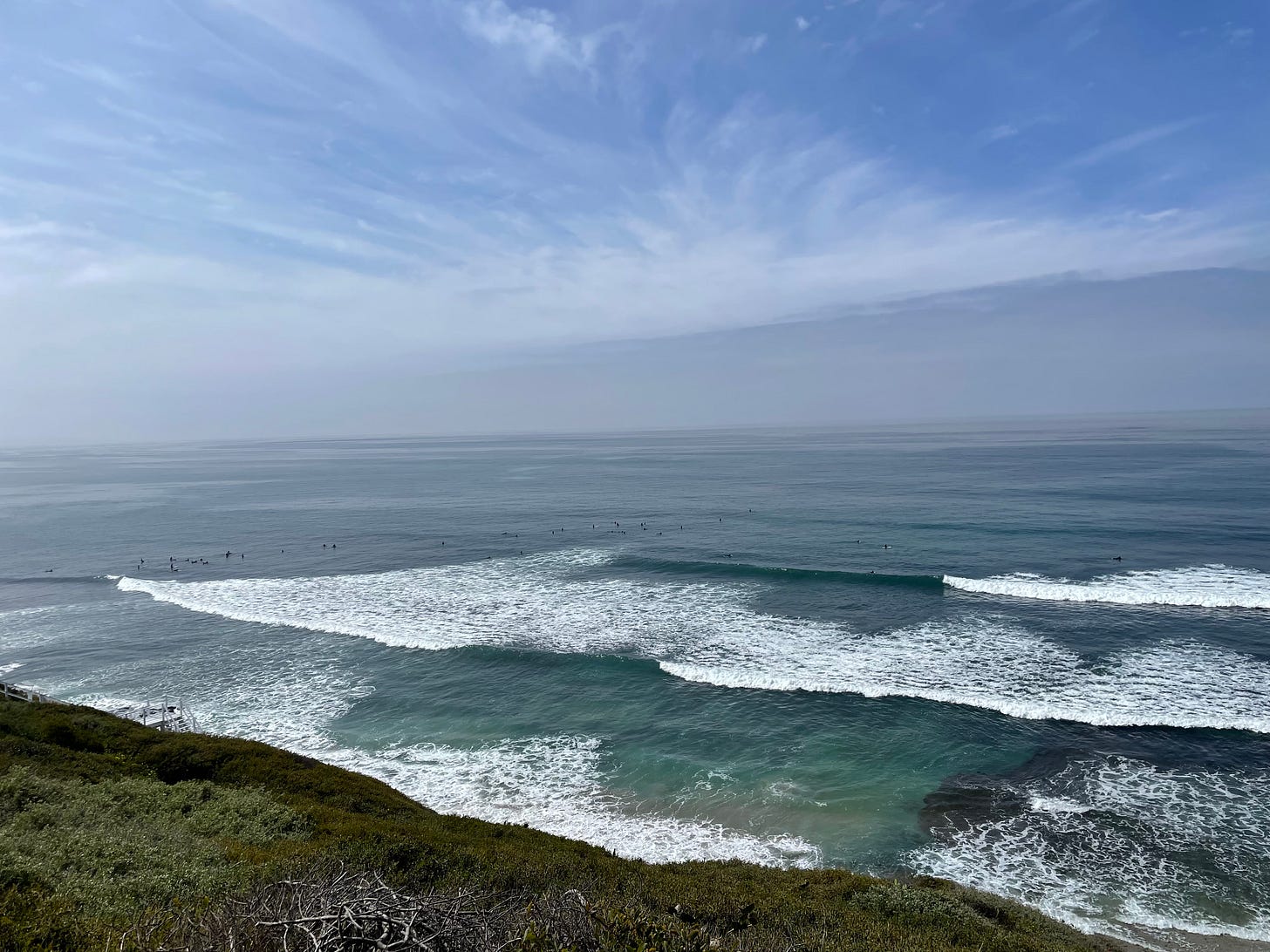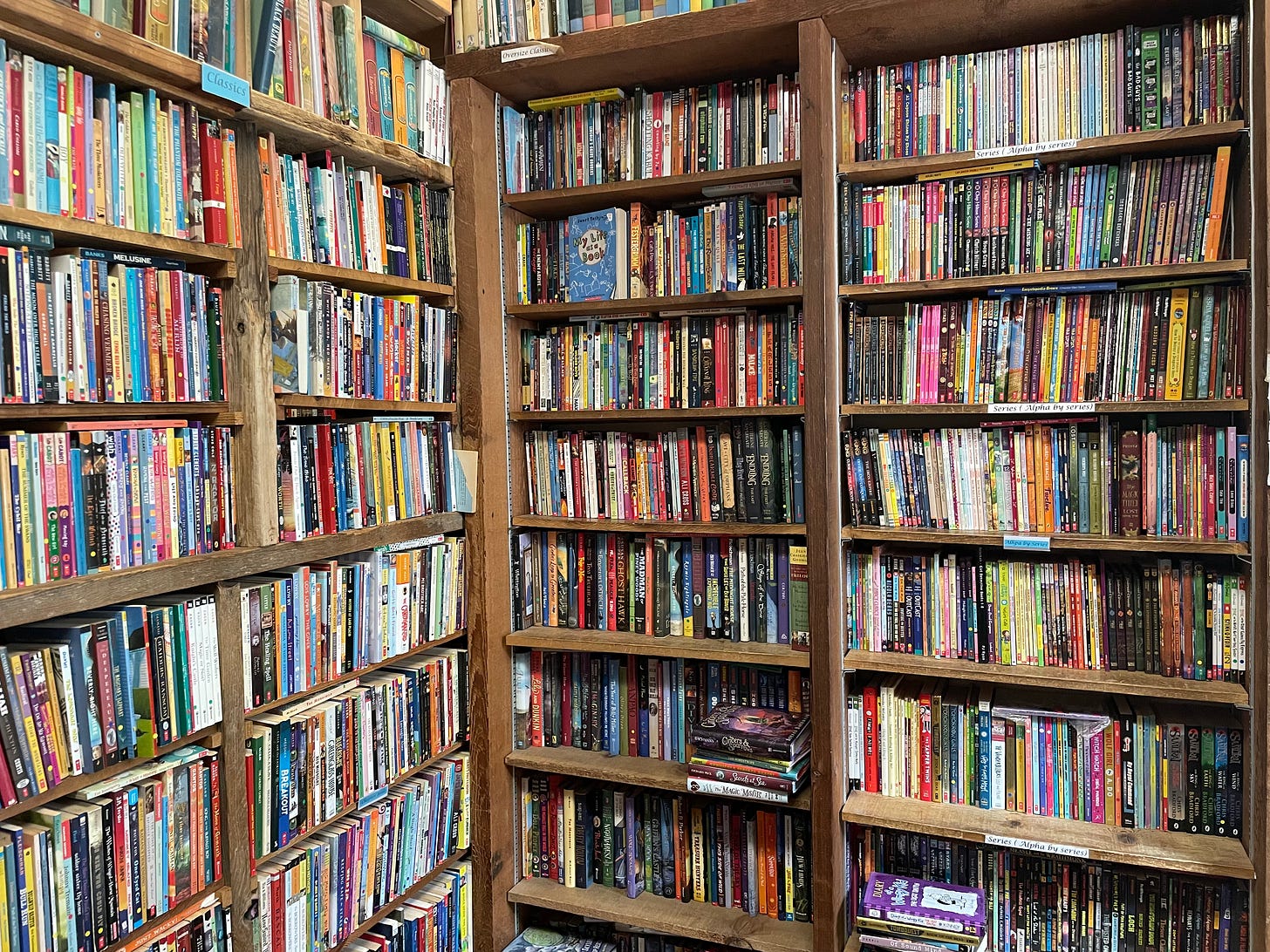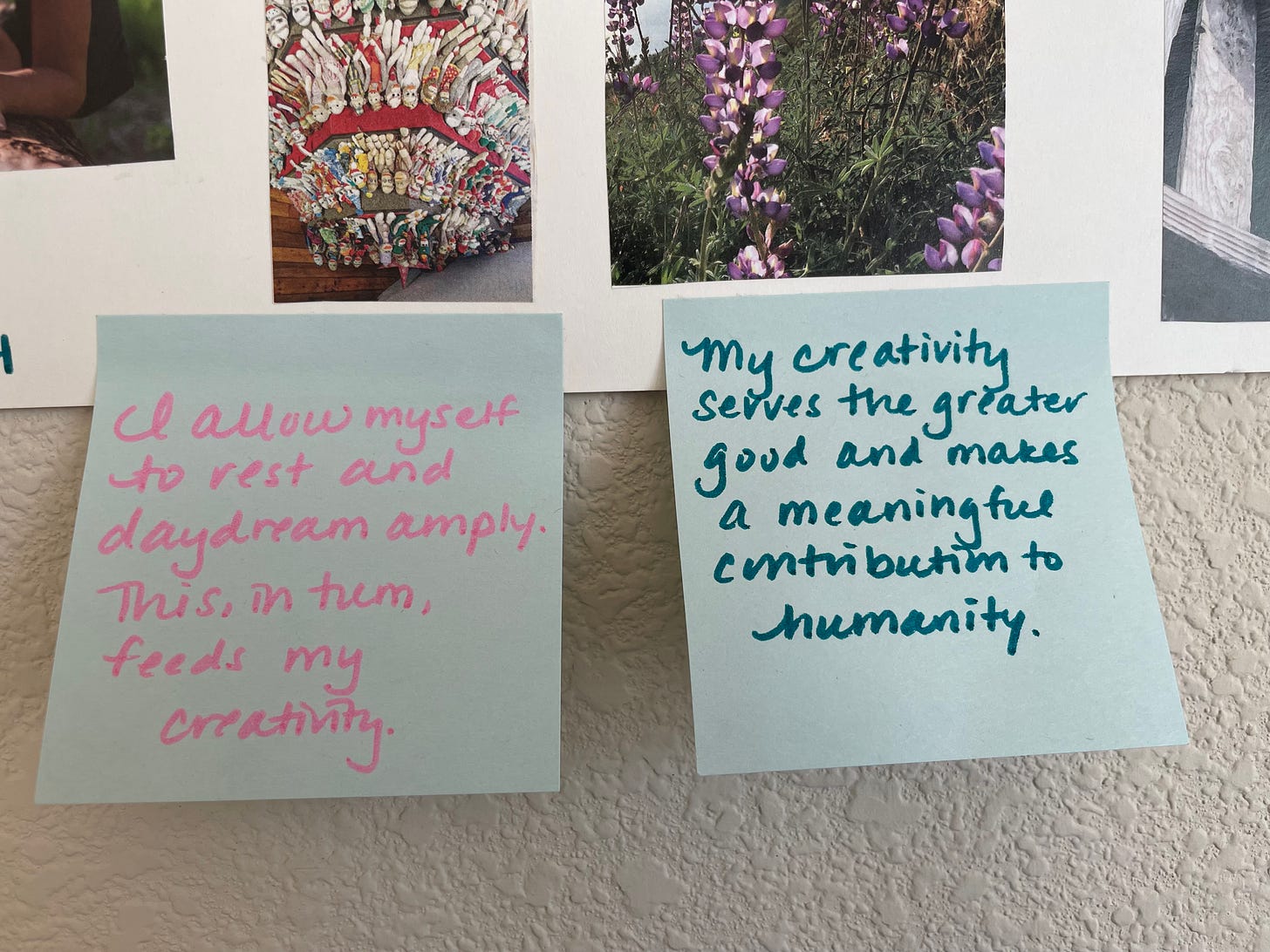📕 The book you didn't know you needed...
A catalyst for creative inspiration and an increasingly aligned life
I first heard of The Artist’s Way — Julia Cameron’s world-renowned creative recovery program — last year. Suddenly, the book started showing up everywhere: podcasts, YouTube videos, newsletters.
Intrigued, I bought a copy this past September and attempted to go through it. Unfortunately, time constraints and the general chaos of life led me to abandon it shortly thereafter. As things slowed down in January and I had more time again, I decided to give The Artist’s Way another go. I’m happy to say that I finished!
For those who don’t know, The Artist’s Way is a 12-week “course in discovering and recovering your creative self,” published originally in 1992 by Julia Cameron. Since its inception, the book has sold over five million copies and has been praised by Hollywood A-listers and bestselling authors alike.
I’ve had lovely conversations with others who’ve also gone through The Artist’s Way, and recommend it whenever I get the chance. In these discussions, a few common words come up: “soul-nourishing,” “life-changing,” “powerful.”
If you’ve been looking for a way to ignite creative inspiration and undergo your own process of personal growth, The Artist’s Way is the book. And no, you don’t need to be an artist or have any other creative hobbies to begin. I believe anyone who goes into the experience with an open mind will notice significant benefits, in many areas of life.

Here’s an overview of what the program entails, the biggest changes I’ve noticed after finishing it, and a couple things to note before starting The Artist’s Way yourself.
What Does The Artist’s Way Consist Of?
The Artist’s Way closely mirrors the language of Alcoholics Anonymous, with its 12-step model and focus on serving a non-denominational higher power (more on this later).
Each chapter centers around recovering a different aspect of our creativity. For example, the first one, “Recovering a Sense of Safety” asks us to examine negative core beliefs and counter them with affirmations.
Cameron’s writing style is beautifully poetic, yet firm. She encourages us to face harsh truths and confront the limitations that hold us back from fully expressing ourselves; from living lives of joy and purpose.
The chapter readings themselves are about 10-15 pages long, plus 10 tasks at the end. When it comes to the tasks, some involve self-reflection while others are more hands-on (for example, one week’s tasks involve going outside to look for rocks — a fun one!). In terms of completing the tasks, Cameron says: “do about half,” choosing “those that appeal to you and those you strongly resist.”
Morning Pages
A core component of The Artist’s Way is the daily stream-of-consciousness Morning Pages. In Cameron’s words, these are “three pages of longhand writing,” not to be shared with anyone else. She states that the Morning Pages are a key component of creative unblocking, as they allow us to get our worries onto the page; to release any petty concerns or express heavy emotions that are weighing us down.
This was originally the area of the program in which I felt the most friction. Three pages a day?! I don’t have that much time! I don’t have that much to say!
But I quickly realized how therapeutic the Morning Pages were. After a couple weeks, it became clear that I needed them, as myriad insights arose in these journalings. The Morning Pages are now a regular habit. They help me work through worries and even write down the details of vivid dreams.
Artist Dates
And now for the fun part… Artist Dates! As Cameron describes them, “An Artist Date is a block of time, perhaps two hours weekly, especially set aside and committed to nurturing your creative consciousness, your inner artist.” She recommends that these dates be taken alone. (I didn’t fully follow this — some experiences are better shared with others!)
What constitutes an Artist Date, exactly? There’s no set guideline, but I took it to mean anything that lets the inner child come out; that lets the imagination run free in the absence of adult responsibilities. A hike. A trip to the bookstore. An art class. A meal at a new restaurant. Something exciting and gloriously untethered to our to-do list.
The biggest challenge for me in this area wasn’t a lack of time, but rather, a sense of guilt. We live in a culture that’s steeped in doing, doing, doing. Prioritizing something as leisurely and purposeless as an Artist Date filled me with productivity guilt at first. But each week, I realized how much these Artist Dates were boosting my mood and outlook. They let me escape from my own worries, allowed me to connect with people, and expanded my creative horizons.
I wrote about a few of my favorites — which included a vision board workshop and peaceful meditation gardens — in this Medium article.

Changes I Noticed After Completing The Artist’s Way
Given the book’s title and premise, I expected creative changes as a result of completing it. I didn’t, however, foresee improvements in my mental health, relationships, and overall lifestyle.
Creative Expansion
The Artist’s Way allowed me to revisit interests I’d long abandoned, or wasn’t devoting as much time to as I liked: dance, drawing, painting, poetry, yoga. It gave me the nudge to sign up for a poetry class in February, which has led to lovely connections and a very supportive group that continues to meet.
It also allowed me to see that resting and focusing on non-writing pursuits are an antidote to writers’ block. After being stuck in a creative rut for much of last year, I’ve developed a newfound enthusiasm for my writing projects. To use an analogy from The Artist’s Way, I’d “filled my well,” and the results have continued to pour forth.
Mental Health Boosts
Now, this is where things get really interesting. When I started The Artist’s Way, I was in a low place emotionally, still recovering from the most intense burnout I’d ever experienced. I was also dealing with overwhelming feelings of uncertainty, as various shifts within my personal life were underway. My spirit needed soothing. And the book provided exactly that.
One of the tasks from Week 9 (“Recovering a Sense of Compassion”) was to go back and reread our Morning Pages, from the very beginning. I picked up on a gradual yet powerful transition in my inner dialogue: it incrementally became more compassionate. I started to remind myself of all that was going well; to pull myself out of spirals of catastrophizing.
I became increasingly honest with myself about various issues I’d been trying to suppress, due to how daunting they felt. Writing them out made them less scary and more overcome-able.
The affirmations have helped me address my issues with self-criticism and self-doubt. I’m believing in myself more and acknowledging that I am enough.
Social/Relationship Improvements
The past several years had been incredibly lonely, and the pandemic certainly played a role, as it did for us all. I’d fallen into a cycle of closing myself off while simultaneously feeling frustrated over the lack of closeness in my life. I was getting in my own way.
The Artist’s Way showed me a simple yet necessary wake-up call: creativity — and by extension, life — aren’t solo endeavors. Solitude is necessary, but there’s a fine line between a healthy amount of alone time and isolation.
I’ve been more intentional about connecting with others through local, in-person groups. I’ve also enjoyed ample time with friends and family, whether that’s through weeknight hangouts in town, weekend adventures, or phone/video calls.
My word for 2024 is “truth,” and I’m finding it easier to be vulnerable in my relationships; to cultivate more of the intimacy I’d been craving.
Lifestyle Modifications
The media deprivation exercise in Week 4 was illuminating, as it helped me confront a modern day struggle: screen consumption habits. I’d already done a lot to address my relationship with social media and scale back on what wasn’t working. But I still felt like I was taking in too much; mindlessly scrolling and then feeling frazzled after.
After the media deprivation, I realized how much time I actually have in a week. I saw how little I got out of instinctive email checks and boredom-induced scrolls. I’m still working on it, but I’m consuming a lot less media and being more mindful around my digital device usage.
I’m keeping my to-do lists lighter, undoing the desire to do as much as possible, and staying more attentive to what’s a true priority. It’s done wonders for my mental health, as well.

Synchronicities
I also have to mention another important concept in the book: synchronicities. From Week 3 (“Recovering a Sense of Power”) onwards, Cameron starts asking us to notice instances of having desires unexpectedly fulfilled.
I’m not sure how often this happened before reading The Artist’s Way. But while going through it, I had multiple synchronicities each week — mostly smaller ones, but a few were significant — that I’d keep record of in my Notes app. For instance, I emailed a story idea to a POPSUGAR’s “Identity” editor back in January, but they passed on it. I jotted down in my planner that I’d reach back out in early April, with an idea related to APIA Heritage Month in May.
Long story short, another editor from the team reached out to me at the end of March. She asked if I could write a piece about my therapy journey from the perspectives of a first-generation South Asian American — a topic I could talk about endlessly — and I accepted the gig. I still can’t believe things worked out this way!
The Artist’s Way: Potential Cons
I initially set out to write a “Pros” section, but I think what I’ve shared thus far speaks to the book’s benefits. We all have different lifestyles, interests, and perspectives, so I understand that The Artist’s Way isn’t for everyone.
The first potential con: although the book isn’t associated with any religion, it does heavily encompass spirituality and use terms like “God” and “the Creator.” Cameron leaves it up to us to decide what that means. However, I know such terms can be problematic for some, and that’s valid. Just something to be aware of.
Another possible con, which was the case for me in my first attempt: the time requirement. I spent about 1-2 hours per day on the readings, tasks, and Morning Pages. And more if I was on an Artist Date.
If you’re tied down with a lot of other commitments right now, I’d recommend waiting until you have more time. The more you’re able to put into the program, the more you’ll get out of it.
The Artist’s Way: Final Reflections
So, if you’ve had a copy of The Artist’s Way sitting on your shelf and are looking for a sign to start, consider this your sign. And if this is the first instance you’re hearing about the book, then I hope it’s found you at a good time.
I know I’ll be returning to The Artist’s Way again, ideally with a group, to have a more collaborative experience.

The Artist’s Way has shown me that honoring our creativity allows us to show up more fully in various facets of life. I truly believe that when we lean into creative expression, we make the world a little better. Our work can reach those who need it, fostering new connections and changing the way we think about certain topics on a societal level.
As Cameron herself says: “No matter what your age or your life path, whether making art is your career or your hobby or your dream, it is not too late or too egotistical or too selfish or too silly to work on your creativity.”
Until next time,
Brina
💭 Reflection
What were some of your favorite hobbies/pastimes as a kid? Which creative pursuits have you been hoping to return to and/or try for the first time?
🎨 Creativity Corner
Book: The Fortune Teller’s Prophecy: A Memoir of an Unlikely Doctor by Lally Pia, MD (Dr. Pia’s powerful memoir just released today, and it’s a beautiful story of resilience after facing immense challenges; she tells it so beautifully with an abundant amount of wisdom and depth)
Article: “I Wasn't Sure How To Celebrate Turning 70. Then I Sent An Email That Changed My Entire Year.” by
in HuffPost (really inspired by this writer’s approach to celebrating a big birthday; an excellent reminder that it’s our shared experiences that give life meaning)YouTube video: “How Stan Culture Keeps You Poor” by Cara Nicole (I always learn so much from Cara’s video essays, and found this one on the financial impacts of superfandom quite fascinating)
Documentary: All That Breathes (this stunning documentary follows two brothers in New Delhi — one of the world’s most polluted cities — who’ve set up a basement bird hospital, nursing black kites back to health; an evocative portrayal of the interconnectedness between us and our non-human companions)







I also enjoyed your Medium article on this!
I’ve been reading this too and have managed morning pages everyday since Jan 23rd (1month and a few days) though I have to admit, I’ve been struggling with the “tasks”. I try to do the artist date, I don’t understand where I’m supposed to write through the reflections/tasks- are they supposed to go in with my morning pages? There is also another book from her based on it called The Writer’s Life. I downloaded the audiobook but the narrator’s voice is very chill and I tend to find myself falling asleep to it or zoning out. I am curious about the podcast mentioned above.